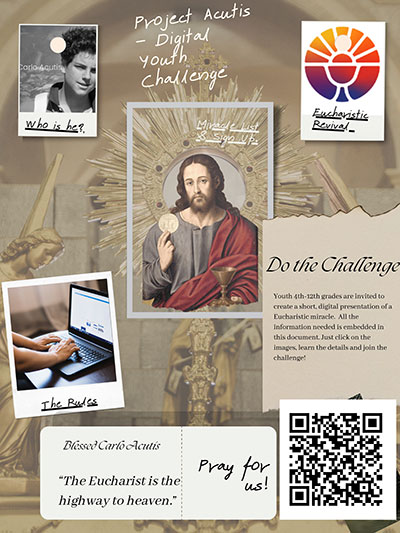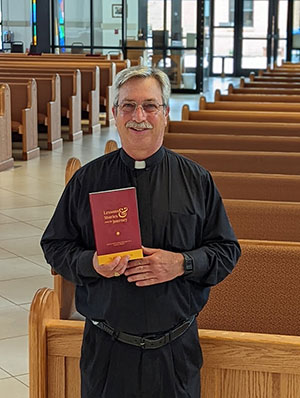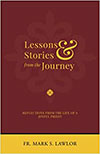Diocesan youth invited to take part in Project Acutis
 CHARLOTTE — Young people throughout the Diocese of Charlotte have an opportunity to show their love for the Eucharist using their digital media skills in Project Acutis, a new faith-filled challenge sponsored by the offices of Catholic Schools and Youth Ministry.
CHARLOTTE — Young people throughout the Diocese of Charlotte have an opportunity to show their love for the Eucharist using their digital media skills in Project Acutis, a new faith-filled challenge sponsored by the offices of Catholic Schools and Youth Ministry.
“Project Acutis is a way for youth of our diocese, grades four through 12, to join with Catholics across the United States in the call to Eucharistic Revival by learning about, being inspired by and evangelizing through the many Eucharistic miracles that have taken place throughout the centuries,” said Paul Kotlowski, the diocese’s director of youth ministry.
Blessed Carlo Acutis, after whom this new youth project is named and dedicated, was an Italian teenager known for his piety, joy and service to others. Born with leukemia, he died in 2006 at age 15 and was buried in Assisi at his request because of his love for St. Francis. He has since captivated the world with his simple holiness. His example has shown youth and adults alike that holiness is possible no matter your age or state in life, even if you like to play video games and wear jeans and sneakers. He was devout as a young child and inspired a deep conversion in his mother. He ensured his family attended Mass daily, supported friends who were suffering through the divorce of their parents, and always stood up for children who were being bullied in school, especially disabled students.
Acutis was also a tech whiz and built a website cataloguing and promoting Eucharistic miracles, where he told people that “the more often we receive the Eucharist, the more we will become like Jesus, so that on this earth we will have a foretaste of heaven.”
For Project Acutis, youth in the diocese choose one of the Eucharistic miracles on the site to use in a multimedia presentation, not to exceed 90 seconds. All youth in grades four to 12 are eligible, and prizes will be awarded to the top entries. Submissions are due Oct. 12, 2023. All submissions will be collected and shared for schools and parishes to enjoy.
Kotlowski encourages youth to look at the work compiled by Blessed Carlo Acutis and see what inspired him to dedicate himself to sharing these supernatural encounters with Jesus.
“It’s hard not to be drawn to Our Lord by these events as curiosity is awakened, and wonder and awe are fueled,” he added. “I pray that by learning about Eucharistic miracles, youth will come to know and believe in the Real Presence of Our Lord in the Eucharist.”
He also said the project is an excellent opportunity for the “young Church of western North Carolina to assist Bishop Peter Jugis in achieving his pastoral priority of becoming more adept in evangelizing in the digital age” as well as his priority for “all to renew and anchor their lives to the Most Holy Eucharist.”
Within his six pastoral priorities, Bishop Jugis noted, “Busy lives bombarded by distracting and worldly messages can only truly find the peace for which they yearn in the paschal mystery” and “We must learn to proclaim the faith in a digital age, that we may better evangelize a culture
teeming with secular and contrary messages.”
By participating in Project Acutis, youth of the diocese can be a much-needed evangelizing voice as they express their love for Jesus in the Eucharist.
— Annie Ferguson
Join the challenge
At www.charlottediocese.org/ev/youth/events/project-acutis: Get details and enter to participate.
‘It’s been a great journey’
 MOORESVILLE — Father Mark Lawlor has been writing down humorous insights and valuable lessons he has learned over the past 30 years. He compiled them into a book, “Lessons & Stories From the Journey: Reflections From The Life of a Joyful Priest,” and it has soared to the top of the charts on Amazon for books written by clergy.
MOORESVILLE — Father Mark Lawlor has been writing down humorous insights and valuable lessons he has learned over the past 30 years. He compiled them into a book, “Lessons & Stories From the Journey: Reflections From The Life of a Joyful Priest,” and it has soared to the top of the charts on Amazon for books written by clergy.
The pastor of St. Therese Church admits the book was a labor of love that has taken him decades to bring to fruition. His inspiration was a book he found in the library at St. Meinrad Seminary: “The Lord and I: Vignettes From the Life of a Parish Priest,” by Father Vincent Fecher.
“I started over 30 years ago, writing down some insights and experiences. I started in seminary taking notes with the idea that I would finish it someday,” Father Lawlor explains.
He says the occasion of his 60th birthday was the catalyst for finally finishing the work.
“This book is not scholarly, but it is from the heart,” he says.
The process of writing the book was a positive experience, he says. “I laughed and I cried. It was good for me to share my experience, my transition from an engineer to priestly formation, then as a parish priest for the last 27 years.”
Father Lawlor dedicated the book to three important women in his life who have passed away: his sister, his mother and his grandmother. There are also chapters in the book that pay tribute to people who have had a profound influence on his life and his vocation.
There is a chapter to the late Bishop William G. Curlin, the third bishop of the Diocese of Charlotte. Bishop Curlin ordained Father Lawlor to the transitional diaconate in 1994 and to the priesthood in June 1995. He was a dear friend and mentor to Father Lawlor, visiting him at St. Vincent de Paul Church in Charlotte often in the years when Father Lawlor served as pastor there. Father Lawlor was among the priests who prayed the rosary at Bishop Curlin’s bedside before he passed away on Dec. 23, 2017.
“Bishop Curlin always lived the priesthood in the way Pope St. John Paul II expressed: ‘The priest does not live for himself, but for the Church and for the sanctification of the People of God,’” Father Lawlor says.
The book’s theme, he emphasizes, is that he considers himself an unlikely candidate for the priesthood. He marvels at all the grace and joy the Lord has poured out upon him since he answered the call to become a priest.
“It’s been a great journey! Life is a journey, and we hopefully learn things as we go.”
—SueAnn Howell, Senior reporter
 Get a copy
Get a copy
Father Mark Lawlor’s book, “Lessons & Stories From the Journey: Reflections From the Life of a Joyful Priest,” is available from Amazon.


 Get a copy
Get a copy